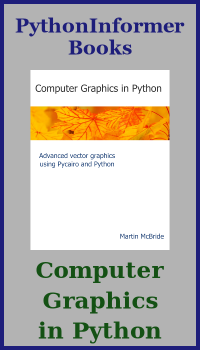Grammar based art with generativepy
Categories: generativepy generative art grammar

Grammar is a term that us usually used in the context of a natural language, such as English. We also use grammars in computing (although it is usually called syntax). And we can use grammars to control the process of generating art with software.
What is a grammar?
The English language contains thousands of words, but the words alone don't define the language. There are also rules about how the words can be combined so that the combination of words can be understood. These rules are called grammar.
Computer programming languages are usually simpler and more rigid than natural languages, but they are also usually recursive. For example in Python, here is an example of an expression:
x + 3
Here is another example of an expression:
x + 3 if y + 1 < z and z ** (a + b) == 7 else n + m
Here the main expression is a conditional expression (the ternary operator) but each of the parts is also an expression. This also happens in natural languages but very complex sentence structures are less common.
Generative art grammars
When we use grammars in generative art, we often work with individual symbols rather than words or variable names. For example in an L system we might define a grammar that only uses the symbols A, B and C.
The grammar defines which combinations of A, B and C are valid.
In addition, each symbol might represent a particular drawing operation.
We can apply the grammar rules to create a complex string of symbols, then we can translate those symbols into drawing operations to create an image based on the symbols.
Using grammars to create art
The grammar itself only tells us if a particular sequence of symbols is valid or not. The grammar itself won't create art.
Some grammars have fixed rules that can be applied automatically. Starting with an initial set of symbols, the rules can be applied to create a new, usually more complex, set of symbols. Eventually the symbols will be converted into drawing operations.
There are other systems where the grammar is less rigid, and at any point there may be several choices available. In that case it is common to use random or semi-random selections to create forms.
Related articles
Join the GraphicMaths/PythonInformer Newsletter
Sign up using this form to receive an email when new content is added to the graphpicmaths or pythoninformer websites:

Popular tags
2d arrays abstract data type and angle animation arc array arrays bar chart bar style behavioural pattern bezier curve built-in function callable object chain circle classes close closure cmyk colour combinations comparison operator context context manager conversion count creational pattern data science data types decorator design pattern device space dictionary drawing duck typing efficiency ellipse else encryption enumerate fill filter for loop formula function function composition function plot functools game development generativepy tutorial generator geometry gif global variable greyscale higher order function hsl html image image processing imagesurface immutable object in operator index inner function input installing integer iter iterable iterator itertools join l system lambda function latex len lerp line line plot line style linear gradient linspace list list comprehension logical operator lru_cache magic method mandelbrot mandelbrot set map marker style matplotlib monad mutability named parameter numeric python numpy object open operator optimisation optional parameter or pandas path pattern permutations pie chart pil pillow polygon pong positional parameter print product programming paradigms programming techniques pure function python standard library range recipes rectangle recursion regular polygon repeat rgb rotation roundrect scaling scatter plot scipy sector segment sequence setup shape singleton slicing sound spirograph sprite square str stream string stroke structural pattern symmetric encryption template tex text tinkerbell fractal transform translation transparency triangle truthy value tuple turtle unpacking user space vectorisation webserver website while loop zip zip_longest
